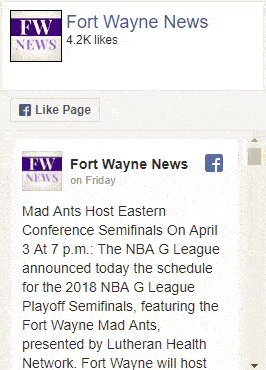Asian carp have one less pathway to the Great Lakes, thanks to the completion of a project announced today by the Asian Carp Regional Coordinating Committee (ACRCC).
The projecta barrier at Eagle Marsh Nature Preserve in Fort Wayne, Indianais intended to keep Asian carp from transferring between the watersheds of the Wabash River in Indiana and the Lake Erie watershed in Ohio, through the Maumee River.
The wetland site is owned jointly by the Little Rivers Wetlands Project and the Indiana Department of Natural Resources. The U.S. Department of Agricultures Natural Resources Conservation Service (NRCS) holds a Wetland Reserve Program (WRP) easement on the site.
The U.S. Army Corps of Engineers (USACE) in its Great Lakes and Mississippi River Interbasin Study (GLMRIS) identified the wetland as a significant pathway for the potential of Asian carp migration to the Maumee River and from there to Lake Erie.
Working closely with the USACE, NRCS designed a berm that was built at the Eagle Marsh site to restrict Asian carp entry into the Great Lakes.
The berm is 1.7 miles long and averages 7.5 feet high. Construction took about three months and used 177,000 cubic yards of compacted fill. The project cost about $4.4 million and used WRP funds from NRCS to construct the berm on the easement and Great Lakes Restoration Initiative (GLRI) funds for work outside of the WRP site.
Staff members from several divisions of Indiana DNR have been actively involved in blocking this pathway ever since its potential was first identified in 2010, DNR director Cameron F. Clark said. There were many moving parts that needed to be kept on track. Led by DNR deputy director John Davis, our team has worked diligently and seamlessly with the other partners to get this important project completed in a timely and efficient manner. Were proud of the role DNR played in reaching this goal.
Betsy Yankowiak, Director of Preserves and Programs for Little River Wetlands Project, said: The Little River Wetlands Project was happy to assist the multiple federal and state agencies in this proactive project to stop the spread of invasive species at our Eagle Marsh Nature Preserve. It has been an incredible experience to work with these groups of dedicated professionals to stop the spread of Asian carp and hundreds of other plants and animals that threaten our waters.
Jane Hardisty, Indiana State Conservationist with the U.S. Department of Agriculture-Natural Resources Conservation Service, said: Some of Indiana NRCS best conservation efforts are partnership projects like Eagle Marsh. This project has benefits that go beyond the important work of excluding invasive Asian carp from the Great Lakes. The restored wetlands reach well beyond their boundaries to improve watershed health and the local economy. Through the leadership of Little Rivers Wetlands Project, this site is also able to be used as an outdoor classroom and for the recreational enjoyment of the community.
Brig. Gen. Richard G. Kaiser, Commander of the Great Lakes and Ohio River Division of the U.S. Army Corps of Engineers, said: Eagle Marsh is a great example of inter-agency efforts coming together to solve an invasive species issue. From the initial study report, through the interim fence measure, to the permanent structure now in place, this project has been a model of partnership and collaboration.
Cameron Davis, senior advisor to U.S. EPA Administrator Gina McCarthy and co-chair of the Asian Carp Regional Coordinating Committee, said: Without bipartisan support for strong Great Lakes Restoration Initiative funding, this project wouldnt have happened. This is just one way the GLRI is showing results.
The project required the involvement of many agencies, including Little Rivers Wetland Project, Indiana Department of Natural Resources, U.S. Department of Agriculture-Natural Resources and Conservation Service, U.S. Army Corps of Engineers, U.S. Environmental Protection Agency, U.S. Geological Survey, and U.S. Fish and Wildlife Service.
The first phase closure consists of the entire berm, with the exception of a small notch (350 feet long) that will be built to the approximate 50-year flood elevation. A mesh screen was installed the length of the notch up to the top of the berm at both ends to prevent alteration of the flood crests, with a screen opening that will block Asian carp at elevations that exceed the 100-year, 1 percent chance flood event. The second phase will remove the screen and fill in the notch but cannot be completed until all flood risk in the area has been mitigated.
Asian carp are widely considered to pose a grave threat to the ecological health, stability and value of the Great Lakes.
Preventing the introduction and establishment of Asian carp into the Great Lakes is a national priority.
